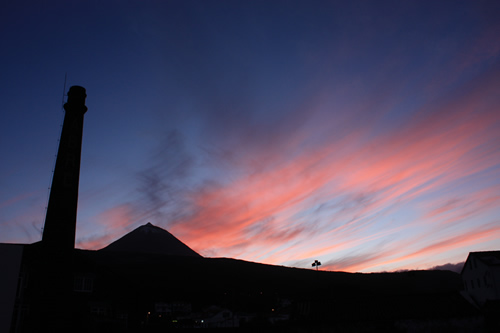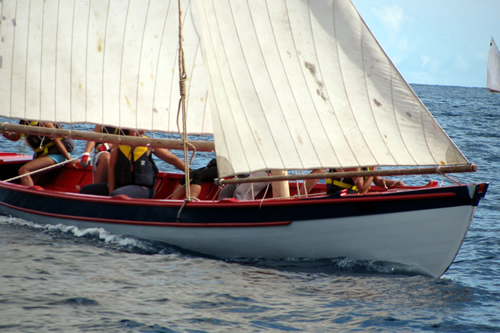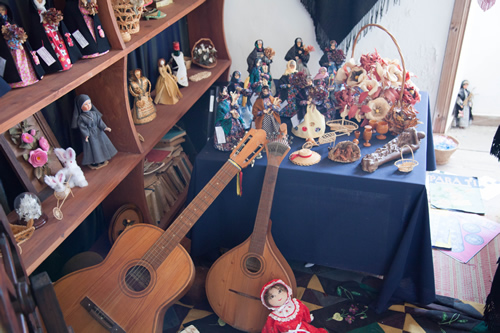Ir para a Versão Portuguesa 
Further Information and Booking, please call:
Ir para a Versão Portuguesa 
Further Information and Booking, please call:
This identity, that the oral and written tradition concentrated, with regard to Pico, in the rude expression of houses, cellars and other buildings, often built in stone masonry without any internal or external plastering, has two high points in the municipality of San Roque: one under the traditional current housing, said "popular" another within the housing of "classical influence," almost sunny.

The concentration in the municipality of “São Roque“ of archaic copies, both in the "popular" house and in those of "classical influence" within a rich and varied collection of architectural types that stimulates the crossover study of influences, confirms the importance of the remaining built heritage of this municipality, as far as traditional housing is concerned.
Although there is no clear boundary between the "popular" and the “classical influence” houses, the attempt to establish a comparative characterization is not vain.
Both groups of accommodation are inserted in rustic environment and adopt common characteristics of the agricultural context, such as having single-storey shops and being often accompanied by buildings to support agriculture. Both of them are, therefore, rural houses. The most obvious differences are the size and frequency, as the common dwellings have fewer and smaller rooms, but can still be found in small groups, while larger houses, having belonged to wealthy and socially prominent owners, are of exceptional occurrence.
Certain constructive and expressive aspects are also common in more ancient homes, regardless of the socio-economic status of those who had it built, including the aforementioned rude and archaic air and tight proportions. The fame of blackness that surrounds the architecture in Pico, results from the use of the volcanic stone without any cladding (stone that appears to be more black here than in any other island), that does not always correspond to a constructive reality. In fact, all the houses of "classical influence" and many of current architecture were plastered and painted white at least in the main façades. But São Roque’s Municipality faces north, so it is less exposed to the sun and more to the influence of sea winds and humidity that reduce to a dark spot any whitewash that is not regularly renewed.
Typical of the most ancient and wealthiest houses is also the use of hipped roof or an adaptation of it to more complex plants. The common house usually has a gable roof. Even more than the expressive characteristics are, however, the functional and internal organization of the housing aspects that must be referred to, and are evident in the existing models typical of São Roque’s municipality. The houses where the kitchen is a separate building from the body of the remaining compartments are today, in Azores, almost exclusive of Pico. These houses with a separate kitchen have, as a rule, two compartments in the body of the rooms on the shops, and both (kitchen and bedrooms) have a rectangular plan. The wealthiest or sunny houses, with more compartments, often have “L" plans. The kitchen, originally separated, is nowadays in the rear, on the edge of the "L" developing or outlining the plan "U".

São Roque’s municipality has one of the most representative "slices" of the landscape dimension of Pico Island: the large area of vines’ cultivation on the north coast, which covers the areas of Santana, Cabrito, Arcos and Lajido. These lands, Landscape of the Culture of Pico’s Island Vineyard, a mixture of lava nature and ancestral cultural practices, were classified as World Heritage by UNESCO in 2004. The zones of Lajido in “Criação Velha” and in “Santa Luzia” are the greatest examples of this art to parcel the land by recognized by this distinction. The landscape of the Culture of Pico’s Island Vineyard, classified in 2004, for being a notable example that illustrates an unique response of the first settlers in the fifteenth century, that through winemaking transformed a rocky and seemingly unproductive landscape, into a mosaic of small parcels of belted stone walls, called "currais" or "curraletas" that protect them from the marine wind but, simultaneously, let in the needed sun for maturation. This work is the real testimony of generations of small farmers who, in a hostile environment, managed to create a way of life and a high quality wine.Talking about Pico’s wine is synonym of pride. The culture of the vine is associated with the early days of the settlement, in the late fifteenth century. The “Verdelho” wine, produced from the vine with the same name, has gained worldwide reputation over the centuries, reaching the table of the Russian Tsars. From the nineteenth century on, new varieties of vine, to produce white and red table wines were cultivated.
Extremely representative of the agricultural cultivation that there has been developed, for centuries, it includes the small stone houses, known as "adegas", real useful constructions and residential by those times, these nucleus (the "adegas" themselves, with notable examples in the place of “Cabrito”), with their fillings (mills, warehouses), their sacred spaces (especially the chapels of “Cabrito” and Our Lady of Purity, this one in the place of “ Lajido de Baixo”, the walls of division of the vineyards (which is a group of "territorial construction "itself) and several additional small objects of production and local rural life (as the wells fill and empty by the sea tide in “Lajido”). Also included in this set, but with its own logic, there are the paths or coastal paths on the stone slabs and stones for the transportation of agricultural products, which grooves can still be found in the area of “Lajido”.

The whaling activity, just as in other municipalities of Pico, - namely in Lajes, was intense in the municipality of São Roque – and from it some remains are still kept, being the most significant the so-called "Whale Factory". This is an old factory of oils and fluors, located in Cais do Pico, today turned into a Museum within the cultural facilities of the Regional Government. The building and its contents (equipment, machinery, furniture and documentation) are a comprehensive witness to the whale hunting activity, which for decades has been an integral part of the experience of Pico labourers, together with its rural dimension – “islenha”. Other useful constructions also with its own value are somehow related to this building, as it is the case of the "Whale water tank" located in Ribeira Seca, and it was intended to supply that manufacturing activity. This "Whale Museum" is to be understood also in conjunction with the other museum of the island, the whalers, located in the municipality of Lajes.
The whale hunting, once the most important economic activity in the island, in recent years, led to the study and observation of whales, dolphins and other marine mammals, being the trip arrangements for the observation of these species arranged by specialised enterprises, from the villages of Madalena and Lajes do Pico.

The religious architecture has also got some examples built with notability in this municipality of Pico’s Island. The most prominent is the Convent of “São Pedro de Alcântara” in São Roque, which is included in the tradition of the Franciscan houses of the islands, with the simplicity of lines and common architectural spaces to all. Today it is an area in transformation to serve as cultural equipment. Its relationship with the surrounding landscape, rural and marine, is remarkable. The Church of “Nossa Senhora da Ajuda” in Prainha, and the Church of São Roque are also to be mentioned as the two most notable in the municipality, considering the decorative originality of the architectural composition.
In conclusion, the Municipality of São Roque do Pico stands out in the Azorean group, mainly due to its large landscape and rural dimension, with notable examples built in of domestic religious and productive architecture.
This identity, that the oral and written tradition concentrated, as far as the island of Pico is concerned, in the rude expression of houses, “adegas” and other buildings, often built in stone masonry without any internal or external plastering, has two relevant authentic examples in the municipality of São Roque: one under the traditional current housing, said "popular" other within the housing "classical influence," almost sunny.
The concentration in the municipality of São Roque of archaic examples, both in the category of "popular" house and in the "classical influence" house, within a rich and varied collection of architectural types that stimulates the crossover study of influences, confirm the importance of the built heritage of this municipality as far as the traditional housing is concerned.
Although there is no clear limit between the houses of "popular" and "classical influence '' the attempt to compare the characterization is not vain.
Both groups of houses are inserted in the rustic environment and share characteristics of the agricultural context, such as having single-storey shops and are often accompanied by buildings to support agriculture. Both of them are therefore rural houses. The most obvious differences are the size and frequency, as the common houses have less and smaller rooms, but can still be found in small groups, while larger homes, having belonged to wealthy and socially prominent owners, are of exceptional occurrence.
Certain constructive and expressive aspects are also common to more ancient homes, regardless of the socio-economic status of those who had it built, including the aforementioned rude and archaic air and the stocky proportions. The fame of blackness that surrounds the architecture of Pico’s island results from the use of the volcanic stone without any plastering (stone that appears to be blacker here than in any other island), that doesn’t always correspond to a constructive reality. Actually, all the houses of "classical influence" and many of current architecture were plastered and painted white at least in the main facades. But the Municipality of São Roque is facing north, less exposed to the sun and more to the influence of sea winds and humidity that reduces to a dark spot any whitewash that is not regularly renewed.

Typical of the most ancient and wealthiest houses is also the use of hipped roof or its adaptation to more complex plans. The common houses usually have a gable roof. Even more than the expressive characteristics are, however, the functional and internal organization of the housing aspects. The houses where the kitchen is in a separate building from the remaining rooms are today, in Azores almost exclusive of the island of Pico. These houses with a separate kitchen have, as a rule, two of the rooms over the shops, and both structures (kitchen and bedrooms) have a rectangular plan. The wealthiest or sunny houses, with more compartments, often have a "L" plan. The kitchen, originally separated, is now next to the rear, on one of the borders of the "L", outlining or developing the plan of "U".
We arent pioneers in the activity, we are rather in HOSPITALITY!
We are a genuine and innovative familiar enterprise, offering holiday houses for tourism, in absolute contact with Nature. We provide our clients with a personalized, unique, professional, honest and complete follow-up service, ever since the first contact.
Our houses, built with passion, combine modernity and ancestry in its architecture, decoration and comfort, to offer our customers unique and memorable vacation experiences in contact with nature and with the culture of a brave and honourable people.
Villa 4Seasons
Property of Solange Rodrigues Gomes
Rua João Bento Lima, N.º24
9940-366 São Roque do Pico - Azores
Telephone Number: (+351) 292 642 091
Mobile: (+351) 918 611 916
Email: info@relaxinpico.com solencantos.relaxing@outlook.pt
/Villa-4-Seasons